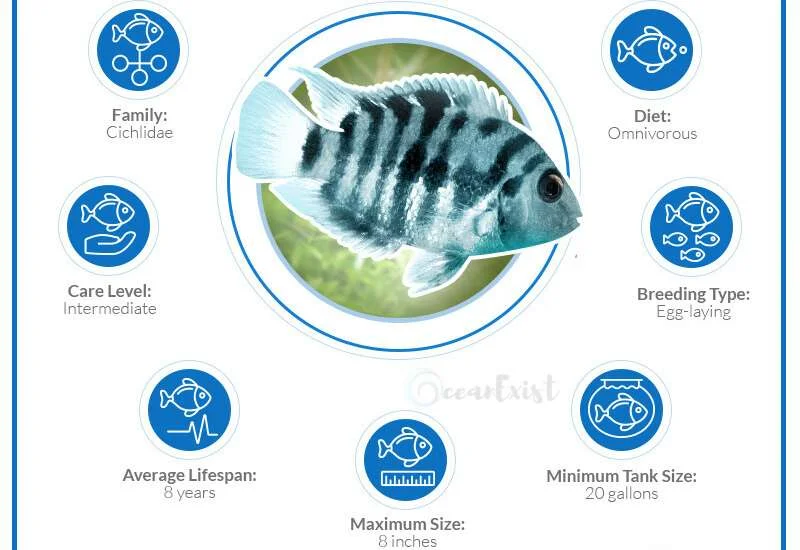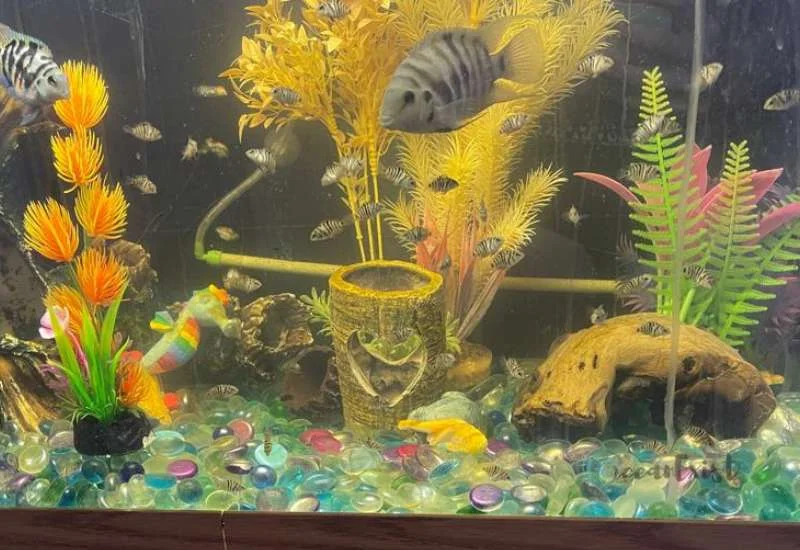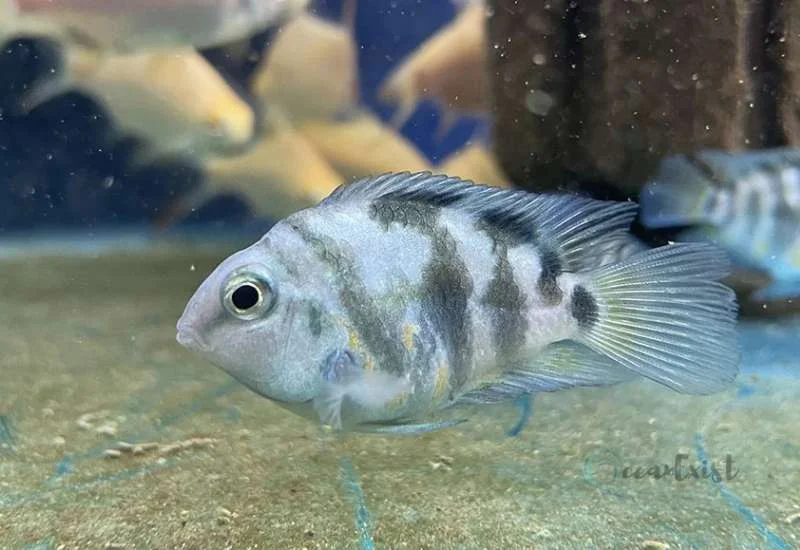All the aquarists search for the most mesmerizing fish in their aquarium tanks. Most newbie fish owners are confused about the selection of fish for their tanks. After detailed research, we have a unique fish that is specifically made for adornment purposes.
Which is that beautiful fish? How can we feed it? How can we breed it? What are the tank requirements for that fish? Everything a fish owner must know will be described here? That is Polar Blue Parrot Cichlid fish.
So, let’s delve into the deep discussion about the Polar Blue Parrot Cichlid fish.
Polar Blue Parrot Cichlid Overview
Polar fish cichlid is an artificially produced fish. It is the product of selective breeding of male convict cichlids and female blood parrot cichlids. So, you will observe the characteristics of both these parent fish. These fish were first found in Taiwan, China, in the 2000s.
Appearance
Polar Blue Parrot cichlids have a pale, grayish-blue color. They have black stripes like the zebra or shiny blue spots on the white base.
These include the fast-growing species. In the first five months, Polar Blue Parrot can achieve a max size of 3-4 inches. The maximum length is about 8 inches of a full grown Polar Blue Parrot cichlids in ideal conditions.
The shape is compact, with a protruding mouth on a round, spherical body. Polar Blue Parrot cichlids got this eye-catching and attractive shape from both these parent species.
Lifespan

The lifespan of a Blue Polar Tiger fish is variable. It depends upon several factors. How do you treat them? What conditions do you provide them? Which type of food do you feed them? And many more parameters decide the lifespan of a fish.
Relatively to other fish, they live longer. In ideal aquarium tank conditions, they can survive 7-8 years.
Male Polar Parrot Cichlid Vs Female Polar Parrot Cichlid
In their childhood, it is nearly impossible to distinguish between males and females. However, their gender are easily differentiated when they are mature.
Unlike other cichlid species, male Polar Parrot Cichlids are thinner than females. They become longer than females when they become mature. Male adult Polar Parrot Cichlid have red tail fins while adult females have blue tail fins.
Another difference appears when they breed. Females develop an orange or yellow spot on the stomach. This spot appears due to the eggs.
Care and food of Polar Blue Parrot Cichlids
The Polar Blue Parrot cichlids are made for Aquarium tanks, so they don’t need the wild-like environment. They are called hardy fish as they can be maintained with a bit of care. Due to the strong hereditary material from both parents, they can survive very harsh water conditions.
Food Of Polar Blue Parrot Cichlids
Polar Blue Parrot Cichlids are omnivores. Although they can eat anything, there are several conditions regarding their feeding habits.
- Their mouths are small protruding and have compact bodies so that they can intake small particles of food. They can’t open their mouths wide.
- Their tube-like digestive system is small in size, but they are over-eaters. So, Polar Blue Parrot Cichlids mostly face the problem of constipation.
- So, feed them in small pellets and flakes that are not only quickly engulfed but also easily digested.
- You can feed them 2-4 times a day but in small quantities.
Polar Blue Parrot Cichlids are over-eaters. They continue eating till you feed them. So, try to feed them enough food that they can eat in 30 seconds. You can feed these cichlids with the following foods.
- Cichlid flakes
- Vegetables like peas, spinach, cucumber, broccoli, lettuce, and zucchini
- Brine shrimp
- Hikari pallets
- Frozen krill
- Frozen bloodworms
- Earthworms
- Crustaceans
- Feeder fish
It is recommended to feed them with Beta-Carotene rich food. This type of food brightens their colors and makes them look attractive.
SUMMARY
Polar Blue Parrot Cichlids require a mild environment to live in tanks. They have a small mouth and compact bodies. Try to feed them small grains of food. Their common food is crustaceans, shrimp, cichlid flakes, etc. They are overeaters, so feed them at proper intervals.
Tank Setup for Polar Blue Parrot Cichlids

When you want to keep Polar Blue Parrot Cichlids in your tanks, you should know the ideal tank conditions for this fish.
Size
One pair will need about a 30-gallon tank minimum. If you provide Polar fish with a 50-gallon tank, they will find more space for adventure and have better growth. After a single breed, transfer them to a 75-gallon tank. A spacious tank will avoid any aggressiveness between the pairs.
Substrate
To increase the beauty of the tank, you can keep substrates in the base of the aquarium. Polar Blue Parrot cichlids can hide and explore these substrates. But make sure these substrates have no sharp edges that can harm fish. And the place of substrate matters a lot.
Select darker substrates instead of lighter ones. The lighter got dirty earlier and gave a very awful impression.
Water Parameters
As described earlier, these fishes can survive harsh water conditions. However, for their ideal growth, one must have the following water conditions:
- Temperature must be 75-85 degrees Fahrenheit
- pH level must be between 5 to 8
- Maintain 9-20 KH water hardness
- Minerals like Ammonia and nitrite levels must be 0 ppm
To maintain all these conditions, you can install a water heater, filtration
The system and a water de-chlorinator for the aquarium are also included.
For maintaining hygienic levels, change 30 % of tank water every week.
Cleanliness of tank
Blue Polar Parrot cichlids are vulnerable to many diseases that are caused by poor water conditions. There are different causes that can pollute water in the tank. The leftover food particles, blasting sand particles, and wastes of fish can make clogs in the tank filter.
So, have a deep cleaning session once a month. It will keep your cichlids safe and healthy.
Tank mates
Polar Parrot fish are aggressive only during the breeding periods. So they can coexist with a variety of fish. But try to keep the same size fish with them. Otherwise there are chances that they will eat them. This behavior is observed with guppies and platies.
If you want to diversify your aquarium, then keep in mind that these are the few suitable options.
- Central American cichlids
- Cory catfish
- Plecos
- Angelfish
- Acaras
- Firemouths
- Kuhli loaches
- Giant gouramis
Make sure the tank mates are docile and friendly in nature. So they will not disturb Polar Parrot Cichlids.
SUMMARY
Substrates, decorations, and robust plants are suitable in tanks for Polar Blue Parrot Cichlids. The fish requires a large tank to swim and hide freely. Proper water cleaning at regular intervals is necessary to keep them. Angelfish, Acaras, Plecos, etc., can be their ideal tankmates.
Polar Parrots Cichlids Disease
If you don’t care about the polar blue parrot fish then you will face different problems with diseases such as health issues so they cannot survive easily. You will have to face white spot diseases and bloat.
These two diseases are hazardous for this species. Mostly, parasites have to face water problems such as too much heat or too much cold for us. Bacterial infections are one of the most common diseases in polar blue parrot fish.
Generally, spot diseases are found due to weakness of the immune system. The symptoms of polar blue parrot fish are given below:
- Fever
- Headache
- Chills
- Muscle pains
- Cough
- Breathing problems
- Pneumonia
Conclusion
Water parameters and the cleanliness of the tank are important factors for polar blue parrot goldfish.
The behavior of polar blue parrot goldfish can be aggressive during breeding. It cannot adjust in a wild environment.
If a person ignores these parameters, such as water substrate level, tank mates, and cleanliness of the tank, they will face some bacterial diseases that can cause death. The substrate can enhance the beauty of the tank. So, decorate the tank with a polar blue parrot goldfish and be happy with aquarium life.
I hope this article will be beneficial for you. If you need more information about polar blue parrot goldfish, then you can read Severum Cichlid Essentials.
